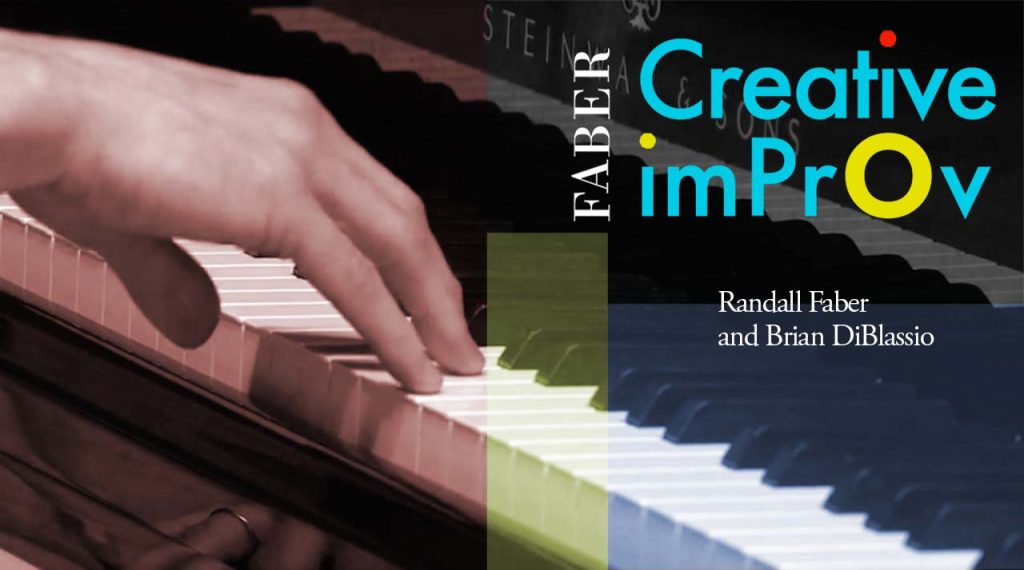
Let’s get creative!
Join your hosts Randall Faber and Brian DiBlassio to learn how bursts of creativity spinning from favorite Piano Adventures songs can make lessons exploratory and fun. Each live webinar provides focused, hands-on training to enhance your teaching toolkit.
Introduction to Creative Improv: You Already Have the Skills to Get Going!
August 4, 1:00pm to 2:30pm ET
Learn how to freely improvise using white and black keys. Discover inspiring sounds hidden within the key of C. Add elements of time and harmonic progression. With swing rhythms and the right starting place, see how the black keys can be transformed into a bluesy sound!
Watch the Recording
Beyond the Printed Page: Opening up Tunes
August 11, 1:00pm to 2:30pm ET
Dive into Creative Improv with favorite tunes from Piano Adventures method and repertoire books. Learn how to apply different musical patterns to create surprising sounds and beautiful textures. Say hello to your new “improv-abilities.”
Watch the Recording
Next Level Improv-abilities for Jazz & Blues
August 18, 1:00pm to 2:30pm ET
An introduction to the blues in the key of C. You’ll learn how to build authentic LH jazz voicings, practice with rhythm tracks, and apply the C blues scale with variations in symmetrical and asymmetrical patterns.
Watch the Recording

As pianist and educator, Randall Faber has appeared as special guest at universities throughout North America and Asia, including the Beijing Central Conservatory, the Shanghai Conservatory and the Royal Conservatory of Canada. He has been Convention Artist for the Music Teachers National Association Conference and master teacher for the World Conference on Piano Pedagogy, National Conference on Keyboard Pedagogy, the Australasian Piano Pedagogy Conference and the USA National Piano Teachers Institute. Dr. Faber holds three degrees from the University of Michigan and a Ph.D. in Education and Human Development from Vanderbilt University. He received a Lifetime Achievement Award in Education from the Roland Corporation in 2019.

Brian DiBlassio is Associate Professor of Music at the University of Michigan – Flint. He composes and arranges for symphonic, chamber, vocal, and jazz ensembles. His work has been performed by the University of Michigan – Flint ensembles, the Flint Symphony Orchestra, and aired on public and national television. As a performer and recording artist, DiBlassio enjoys performing jazz, Latin jazz, and classical piano. He holds degrees from the University of Miami and the University of Michigan, and teaches privately in Ann Arbor, MI. Brian joins Faber Piano Adventures as a clinician with focus on teaching jazz and creative improvisation.
Webinars are free and open to all. Teacher Atlas members will have access to webinar recordings.
5 replies on “New Webinar Series for Teaching Creative Improv”
Comments are closed


Hello:
I am a classic-trained piano teacher. Truly like to learn more about learning and teaching Jazz and improvisation. I subscribed the teacher Atlas and learn from the vedios.
From the vedio of ” Misty ” from Level 3A, Brian introduced ‘shell’. He showed how to play but not explained why the chords were formed like that. Is there a way I could know why the two chords are formed as an introduction before G chords?
I am interested in this webinar, but will be working at the times listed. Is there a way that I can watch it at another time?
Hi Suzanne — Thanks for your interest in the Creative Improv webinars. Recordings will be available in the Teacher Atlas. If you’re not already a member, you can enroll for a 30-day free trial to watch the webinar recordings. Here is a link to the Teacher Atlas for your convenience: https://cloud.pianoadventures.com/products/teacher-atlas/
Hello, Summer! Thanks for the question. Here is a response from our clinician Brian DiBlassio:
The term “shell” is sometimes used for LH jazz voicings in the mid-low range of the piano. Quite literally, they are a “shell,” or part of full root position 7th chords. Shells are used instead of full root position chords because the latter sound too blocky, thick, and muddy. For example, the first two chords mentioned in the introduction to Misty were Bm7 and E7. The “shell” notes chosen to represent those full chords were B up to A for the Bm7, and E up to G# for the E7. The full chord progression suggested for the Misty intro was Bm7 E7 Am7 D7, or a iii VI7 ii7 V7. The “VI7” is shorthand for the secondary dominant V7/ii.
Hope this helps!
Brian DiBlassio
PS The above information was not included in the video because the videos need to straddle delivery to both students and teachers, so it would be overload for students alone 🙂
These webinars look very interesting and useful for teachers to “diversify” their own piano teaching, especially for classically trained pianists who has less experience in doing improvisations!